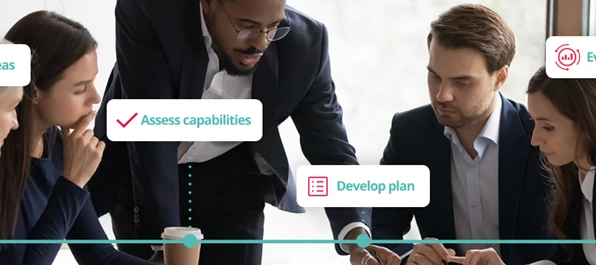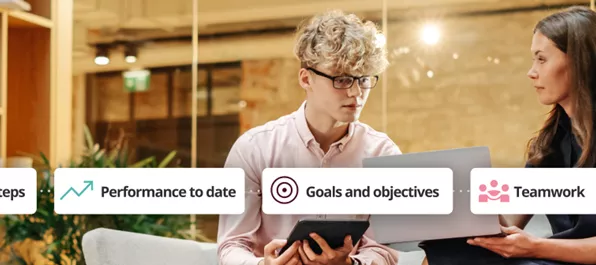
Implementing a new HR system in six steps
Digital transformation, employee experience and change management are now topping the list of HR priorities and they are essential considerations when deciding why, when and how to implement a new HR system. A new system can transform your people processes and revolutionise the way you operate – with the right implementation planning.
The implementation of a fully integrated cloud-based HR system like PeopleXD can help HR and payroll teams to address their challenges and improve the automation of their people processes, as well as advancing digital transformation. This article will help you set the right goals and implement your new HR system to meet them – we cover everything from project management, to testing and learning, and system rollout.
 10 minutes
10 minutes
Written by The Access Group
Six key steps to implement a HR system
The following are the six key steps we discuss with customers that we feel are worth following when implementing a new HR system:
- Project planning
- Installation and configuration
- Onboarding and training
- Testing
- Rollout
- Monitoring
Note that there will likely be some fluidity here. For example, you may train HR members who will be involved in implementation ahead of the system rollout, while other members of staff will be trained afterwards. Take this guide and adapt it for your own purposes. The main takeaway is that an implementation project needs to be carefully planned ahead of time. One of the biggest risks is lack of planning and rushing – take the time to plan, scope, set KPIs and implement effectively or you could end up allocating significant budget to a system that doesn’t operate the way you need it to.
The implementation of a new HR system will likely include an internal team, alongside a vendor’s solutions consultants to support with the technical functionality and customisations. Some organisations also choose to use third party consultants to help them select a HR system that is best for their needs and then to roll this out.
By the time you come to planning the implementation of your HR system, you should already have selected the right one for you and will be clear on its features and benefits. If you are at an earlier stage in the process, take a look at our guide to choosing the right HR system.
Step 1: Project planning
Your HRIS implementation project plan will be your essential blueprint for implementing a new HR system. This should include scope, timeline and stakeholders as well as anything else that is important to the success of the project. If stakeholders sit in different parts of the business, ensure you have common goals, a plan for communicating the project deliverables and updates, and agree on when and how often they need to be involved.
When setting the project scope, consider setting SMART goals to eliminate scope creep. Smart stands for specific, measurable, achievable, relevant and time bound. Smart goals help you clarify ideas, focus efforts and use time wisely so you get more out of your project.
By the time you are planning your system implementation project, you should have decided on your software and budget. You will already be very familiar with its key functionality, so make sure this translates into the HRIS implementation project plan and you know how each aspect of the system should be set up to perform in the way you need it to. Taking the time to get this part right is crucial before moving on to the next step.
Scoping questions to consider:
- What is the project timeline?
- Who holds key responsibilities? Who is the dedicated project manager?
- What does a successful project outcome look like?
Step 2: HR system installation and configuration
During this stage, you will get your system set up in the correct way for your organisation so you can start feeling the benefits straight away. You will configure processes, platform integrations, team structure and anything else that you need your system to do, from benchmarking, to report generation, to HR analytics.
Data entry is an essential part of this – your new system will rely on the data you feed into it to work, so it needs to be accurate. You will need to plan how to migrate data over from your current system, as well as carrying out data cleansing and updating any records as needed. Your HR system supplier should be well versed in data migration, with the ability to ensure your data is migrated securely and in compliance with GDPR and other data protection legislation.
Installation at this point will also likely include integrations with your other HR systems, if you have not opted for a complete digital transformation of all of your HR solutions into one integrated system. Your supplier should have scoped your integration requirements into your project to discover how many systems need integrating, whether they all have open APIs and the order this will need to be done in.
Take a look at our guide to the benefits of an integrated HR system.
Installation tends to be simpler with an out of the box cloud-based system like PeopleHR for example, but you’re still likely to need the expertise of your IT, data and technology departments if you have them. Make sure you have the correct people involved from the start and if you lack them internally, these are services that can be sourced externally or taken care of by your HR system vendor.
Scoping questions to consider:
- Who will carry out installation and what support will you need from other teams?
- Where will the data come from for system configuration?
- Who will be responsible for data and what exactly is required?
- How integrated do you need to be with other systems in the HR/IT ecosystem?
Step 3: Onboarding and training
Everyone using your HR system should receive full training and onboarding support. There may be support available from your system provider, including documentation and live training sessions. Training should address the individual needs of different employees, focusing on the ways they interact with the system and its various features. Should employees have questions or require support, ensure that a direct contact is available. This person should be readily available and suitably knowledgeable to help manage a smooth transition for everyone.
Scoping questions to consider:
- Who needs to be trained to use the new HR system?
- What do different groups of employees need to know and how will you divide up training?
- Will training be monitored and if so, how?
- When do employees need training?
- Who needs training prior to rollout and who needs training once the system is set up and fully functional?
Step 4: HR system testing
Once key HR employees know how to use the system, it will need to be thoroughly tested. This step should not be confused with feedback – this is about testing basic operation, ensuring that the system does what you need it to do and that any major issues are caught early. You will likely need to implement a soft launch to test the system with a pilot team initially. There will almost certainly be teething troubles, so be prepared and remain flexible.
When organising testing, consider carefully who will be taking part. It’s sensible to test with a range of stakeholders, as well as people who have differing levels of experience with HR systems - it needs to be a team effort. This way, you can find out if the system is properly configured for each group to get what they need from it.
Scoping questions to consider:
- Who will test the system?
- How will they be using the system?
- How long will the testing period be?
- Will you ask testers specific questions or set up particular scenarios?
- How will issues be raised by the tester and prioritised by the vendor?
Step 5: Full rollout
You’re ready to roll out your HR system to your wider organisation. Bake internal communications into your strategy here, making sure people know what’s changing, why it’s changing and how it will benefit them. They should also be informed about access, training and support. Effective internal communications at this point will ensure higher employee engagement rates, enabling you to free up HR admin time from the start, rather than having to field questions about the new system and how it works.
Pick your go-live day strategically. If possible, choose a quiet day to avoid complications and give people the time they need to start exploring the system. You can track system usage if required to make sure people are logging in as required, which also helps you to offer proactive support as needed.
Scoping questions to consider:
- What is the ideal rollout date?
- What do you need to do before rollout?
- Who needs to be included in the comms plan and what should they be told?
- Will this be a soft launch or an all-at-once approach?
Step 6: Fine tuning and monitoring
Implementing a new HR system successfully doesn’t stop at rollout. Even after extensive testing and user training, there will likely be some issues that slip through the net – most HR systems are vast, complex and have so many options. And if there are no issues, there will at the very least be questions and additional considerations. Record feedback somewhere central and proactively use it to improve and enhance your system going forward.
Scoping questions to consider:
- How will you monitor ongoing usage?
- Where will you record feedback?
- How will feedback be used? Will there be a steering committee, perhaps?
- Will you have/do you need ongoing support from your HR system provider to get the best out of it?
Bonus tip: Work closely with your HR system provider during implementation
Your provider has implemented HR systems for many businesses, many times before. They are an excellent resource throughout the implementation process and can guide you through it to avoid pitfalls and maximise the success of your system.
Take a look at our end-to-end cloud-based HR system PeopleXD
How to support employees during implementation
During the implementation project, it’s important to support both HR employees and employees from the wider business. It may be the case that some business-as-usual HR functions are limited while the new system is being implemented, so managing employee expectations and finding interim solutions is key.
For HR employees, ensure that:
- In-depth training is provided for the system, which should be planned in advance for an effective rollout
- Individuals have the opportunity to test, provide feedback and be involved in the implementation process
- Access and technology requirements are managed proactively for a smooth transition
For all employees, ensure that:
- Communication is clear and is sent well ahead of time to manage expectations
- Training is provided for new functionality, especially if moving to self-service options for essential documentation such as payslips
- Software has been thoroughly tested before rolling it out to the wider business, improving employee experience during the transition
Bringing it all together: An essential HRIS implementation checklist
- Project planning
- What is the project timeline?
- Who holds key responsibilities?
- What does a successful project outcome look like? - HR system installation and configuration
- Who will carry out installation and what support will you need from other teams?
- Where will the data come from for system configuration?
- Who will be responsible for data and what exactly is required?
- How integrated do you need to be with other systems in the HR/IT ecosystem? - Onboarding and training
- Who needs to be trained to use the new HR system?
- What do different groups of employees need to know and how will you divide up training?
- Will training be monitored and if so, how?
- When do employees need training? Who needs training prior to rollout and who needs training once the system is set up and fully functional? - HR system testing
- Who will test the system?
- How will they be using the system?
- How long will the testing period be?
- Will you ask testers specific questions or set up particular scenarios?
- How will issues be raised by the tester and prioritised by the vendor? - Full rollout
- What is the ideal rollout date?
- What do you need to do before rollout?
- Who needs to be included in the comms plan and what should they be told?
- Will this be a soft launch or an all-at-once approach? - Monitoring
- How will you monitor ongoing usage?
- Where will you record feedback?
- How will feedback be used? Will there be a steering committee, perhaps?
- Will you have/do you need ongoing support from your HR system provider to get the best out of it?
Upgrading to a cloud-based HR system will likely require stakeholder buy-in. Take a look at our guide on how to build a business case for HR software.
Next steps
This guide has explored 6 steps in implementing a HRIS with some key recommendations for achieving a successful HR software implementation. If you’re ready to upgrade your HR software and implement a new system, get in touch with our HR and payroll software specialists to discuss the best approach and how we can support you. With more than 30 years of experience delivering tailored solutions to 75,000+ customers in the UK, Ireland and Asia Pacific, we can help you to automate HR and payroll processes, drive greater operational efficiencies and enhance your employee experience.
Fill out the contact form to get started. We’ll set up a conversation with an HR expert who can discuss your software needs with you.
Contact us
Simply fill in the form and our friendly team will be in touch to arrange a call with one of our HR and payroll experts.
Learn more with our HR and Payroll blogs
Our HR and payroll blogs offer advice and guidance from industry experts.



